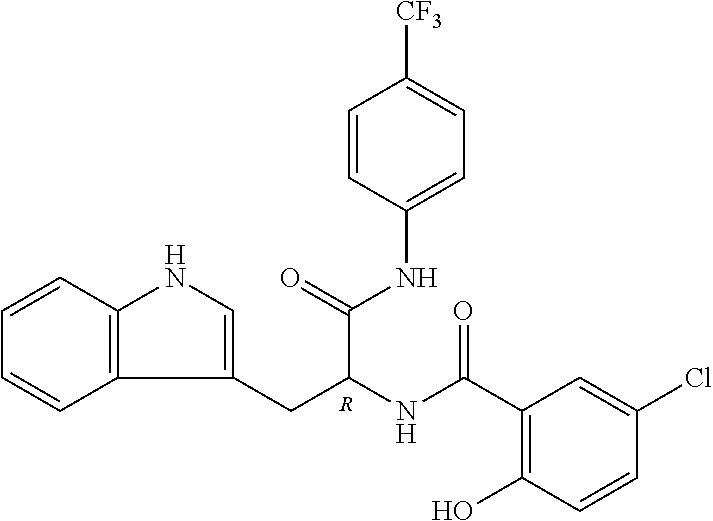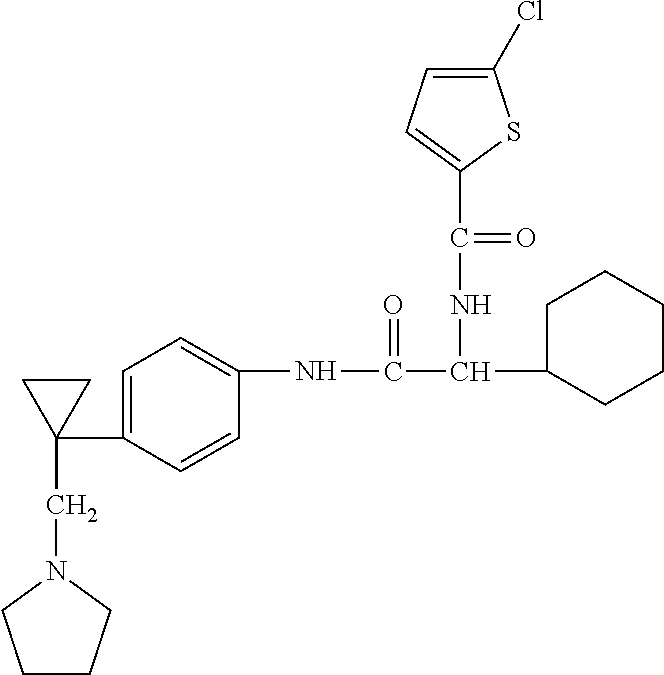Amide compound
a compound and amide technology, applied in the field of amide compounds, to achieve the effect of superior rort inhibitory action
- Summary
- Abstract
- Description
- Claims
- Application Information
AI Technical Summary
Benefits of technology
Problems solved by technology
Method used
Image
Examples
example 1
N-(3,5-difluoro-4-(trimethylsilyl)phenyl)-2-(((6-oxopyrimidin-1(6H)-yl)acetyl)amino)-2-(tetrahydro-2H-pyran-4-yl)acetamide
(Step 1)
[1732]To a solution of 1,3-difluoro-5-nitrobenzene (3 g, 18.86 mmol) in THF (60 mL) was added trimethylsilyl chloride (7.23 mL, 56.57 mmol) at −78° C. under nitrogen atmosphere. To the reaction solution was added sodium hexamethyldisilazide (19.85 mL, 37.71 mmol), and the mixture was kept at −75° C. or lower. The reaction solution was stirred for 1 hr, and water and ethyl acetate were added thereto. The organic layer was separated, and the aqueous layer was extracted with ethyl acetate. The organic layer was dried over magnesium sulfate, and the solvent was evaporated under reduced pressure. The obtained residue was purified by silica gel column chromatography (solvent; hexane) to give (2,6-difluoro-4-nitrophenyl)trimethylsilane (3.51 g, 15.18 mmol, 80%) as a colorless oil.
[1733]1H NMR (300 MHz, CDCl3): δ0.42 (9H, s), 7.61-7.71 (2H, m).
(Step 2)
[1734]A sol...
example 2
N-(3,5-difluoro-4-(trimethylsilyl)phenyl)-2-(((5-methyl-1,3,4-oxadiazol-2-yl)acetyl)amino)-2-(tetrahydro-2H-pyran-4-yl)acetamide
(Step 1)
[1747]To a solution of ethyl 2-(5-methyl-1,3,4-oxadiazol-2-yl)acetate (279 mg, 1.64 mmol) in a mixed solvent of water (2 mL) and THF (1 mL) was added lithium hydroxide monohydrate (68.9 mg, 1.64 mmol), and the mixture was stirred at room temperature for 1 hr. The reaction mixture was concentrated under reduced pressure, and the residue was subjected to azeotropy with toluene to give lithium 2-(5-methyl-1,3,4-oxadiazol-2-yl)acetate (250 mg, 1.689 mmol, 103%) as a white solid.
[1748]1H NMR (300 MHz, DMSO-d6): δ2.41 (3H, s), 3.35 (2H, s).
(Step 2)
[1749]A solution of 2-amino-N-(3,5-difluoro-4-(trimethylsilyl)phenyl)-2-(tetrahydro-2H-pyran-4-yl)acetamide (48 mg, 0.14 mmol), HATU (58.6 mg, 0.15 mmol), DIEA (0.027 mL, 0.15 mmol) and lithium 2-(5-methyl-1,3,4-oxadiazol-2-yl)acetate (22.83 mg, 0.15 mmol) in DMF (4 mL) was stirred at room temperature for 1.5 hr...
example 3
N-((1R)-2-((3,5-difluoro-4-(trimethylsilyl)phenyl)amino)-2-oxo-1-(tetrahydro-2H-pyran-4-yl)ethyl)-3-hydroxy-1,2-oxazole-5-carboxamide
[1752]A solution of 2-amino-N-(3,5-difluoro-4-(trimethylsilyl)phenyl)-2-(tetrahydro-2H-pyran-4-yl)acetamide (100 mg, 0.29 mmol), COMU (138 mg, 0.32 mmol), DIEA (0.056 mL, 0.32 mmol) and 3-hydroxy-1,2-oxazole-5-carboxylic acid (41.5 mg, 0.32 mmol) in DMF (2 mL) was stirred at room temperature for 2 hr. To the reaction mixture were added water and ethyl acetate, and the organic layer was separated. The organic layer was dried over magnesium sulfate, and the solvent was evaporated under reduced pressure. The obtained residue was purified by silica gel column chromatography (solvent gradient; 0→10% MeOH / ethyl acetate) to give N-(2-((3,5-difluoro-4-(trimethylsilyl)phenyl)amino)-2-oxo-1-(tetrahydro-2H-pyran-4-yl)ethyl)-3-hydroxy-1,2-oxazole-5-carboxamide (107.5 mg, 0.237 mmol, 81%) as white crystals.
[1753]The obtained compound (107 mg) was subjected to optic...
PUM
 Login to View More
Login to View More Abstract
Description
Claims
Application Information
 Login to View More
Login to View More - R&D
- Intellectual Property
- Life Sciences
- Materials
- Tech Scout
- Unparalleled Data Quality
- Higher Quality Content
- 60% Fewer Hallucinations
Browse by: Latest US Patents, China's latest patents, Technical Efficacy Thesaurus, Application Domain, Technology Topic, Popular Technical Reports.
© 2025 PatSnap. All rights reserved.Legal|Privacy policy|Modern Slavery Act Transparency Statement|Sitemap|About US| Contact US: help@patsnap.com



